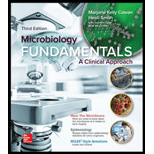
Microbiology Fundamentals: A Clinical Approach
3rd Edition
ISBN: 9781259709227
Author: Marjorie Kelly Cowan Professor, Heidi Smith
Publisher: McGraw-Hill Education
expand_more
expand_more
format_list_bulleted
Concept explainers
Question
Chapter 6.1, Problem 2NP
Summary Introduction
Introduction:
The elements which cannot be synthesized by body, but are needed in the growth of the organism are known as essential nutrients, these nutrients are obtained from the surrounding. On the basis of requirement the nutrients are classified into two categories macronutrients and micronutrients.
Expert Solution & Answer
Want to see the full answer?
Check out a sample textbook solution
Students have asked these similar questions
glg 112 mid unit assignment Identifying melting processes
Give only the mode of inheritance consistent with all three pedigrees and only two reasons that support this, nothing more, (it shouldn't take too long)
O
Chapter 6 Solutions
Microbiology Fundamentals: A Clinical Approach
Ch. 6.1 - List the essential nutrients of a bacterial cell.Ch. 6.1 - Prob. 2AYPCh. 6.1 - List and define four different terms that describe...Ch. 6.1 - Prob. 4AYPCh. 6.1 - Compare and contrast the processes of diffusion...Ch. 6.1 - Identify the effects of isotonic, hypotonic, and...Ch. 6.1 - Name two types of passive transport and one type...Ch. 6.1 - Prob. 1NPCh. 6.1 - Prob. 2NPCh. 6.1 - Prob. 3NP
Ch. 6.1 - Prob. 1MMCh. 6.2 - List and define five terms used to express the...Ch. 6.2 - Summarize three ways in which microorganisms...Ch. 6.2 - Identify three important environmental factors...Ch. 6.2 - List and describe the five types of associations...Ch. 6.2 - Discuss characteristics of biofilms that...Ch. 6.2 - Which statements are true with respect to...Ch. 6.3 - Summarize the steps of cell division used by most...Ch. 6.3 - Define doubling time, and describe how it leads to...Ch. 6.3 - Compare and contrast the four phases of growth in...Ch. 6.3 - Identify one culture-based and one...Ch. 6.3 - Prob. 2MMCh. 6 - Which descriptors are likely to have applied to...Ch. 6 - Prob. 2QCh. 6 - Speculate about how earths atmosphere came to...Ch. 6 - Which of the following is true of passive...Ch. 6 - Compare the effects of a hypertonic, hypotonic,...Ch. 6 - Usually scientists looking for life on other...Ch. 6 - An organism that can synthesize all its required...Ch. 6 - Provide evidence in support of or refuting this...Ch. 6 - Develop an explanation for why biofilm bacteria...Ch. 6 - Most bacteria increase their numbers by a. sexual...Ch. 6 - Looking at figure 6.3, explain how a cell in a...Ch. 6 - In binary fission, the parent chromosome is...Ch. 6 - A cell exposed to a hypertonic environment will...Ch. 6 - Prob. 14QCh. 6 - Bacteria and archaea are ubiquitous on the planet....Ch. 6 - Prob. 16QCh. 6 - How can you explain the fact that an unopened...Ch. 6 - Prob. 18QCh. 6 - In a viable count, each ____ represents a ______...Ch. 6 - If an egg salad sandwich sitting in a car on a...Ch. 6 - Scientists now believe that most bacteria in...Ch. 6 - Prob. 1VC
Knowledge Booster
Learn more about
Need a deep-dive on the concept behind this application? Look no further. Learn more about this topic, biology and related others by exploring similar questions and additional content below.Similar questions
- Describe the principle of homeostasis.arrow_forwardExplain how the hormones of the glands listed below travel around the body to target organs and tissues : Pituitary gland Hypothalamus Thyroid Parathyroid Adrenal Pineal Pancreas(islets of langerhans) Gonads (testes and ovaries) Placentaarrow_forwardWhat are the functions of the hormones produced in the glands listed below: Pituitary gland Hypothalamus Thyroid Parathyroid Adrenal Pineal Pancreas(islets of langerhans) Gonads (testes and ovaries) Placentaarrow_forward
- Describe the hormones produced in the glands listed below: Pituitary gland Hypothalamus Thyroid Parathyroid Adrenal Pineal Pancreas(islets of langerhans) Gonads (testes and ovaries) Placentaarrow_forwardPlease help me calculate drug dosage from the following information: Patient weight: 35 pounds, so 15.9 kilograms (got this by dividing 35 pounds by 2.2 kilograms) Drug dose: 0.05mg/kg Drug concentration: 2mg/mLarrow_forwardA 25-year-old woman presents to the emergency department with a 2-day history of fever, chills, severe headache, and confusion. She recently returned from a trip to sub-Saharan Africa, where she did not take malaria prophylaxis. On examination, she is febrile (39.8°C/103.6°F) and hypotensive. Laboratory studies reveal hemoglobin of 8.0 g/dL, platelet count of 50,000/μL, and evidence of hemoglobinuria. A peripheral blood smear shows ring forms and banana-shaped gametocytes. Which of the following Plasmodium species is most likely responsible for her severe symptoms? A. Plasmodium vivax B. Plasmodium ovale C. Plasmodium malariae D. Plasmodium falciparumarrow_forward
- please fill in missing parts , thank youarrow_forwardplease draw in the answers, thank youarrow_forwarda. On this first grid, assume that the DNA and RNA templates are read left to right. DNA DNA mRNA codon tRNA anticodon polypeptide _strand strand C с A T G A U G C A TRP b. Now do this AGAIN assuming that the DNA and RNA templates are read right to left. DNA DNA strand strand C mRNA codon tRNA anticodon polypeptide 0 A T G A U G с A TRParrow_forward
arrow_back_ios
SEE MORE QUESTIONS
arrow_forward_ios
Recommended textbooks for you
- Essentials of Pharmacology for Health ProfessionsNursingISBN:9781305441620Author:WOODROWPublisher:Cengage
- Surgical Tech For Surgical Tech Pos CareHealth & NutritionISBN:9781337648868Author:AssociationPublisher:Cengage


Essentials of Pharmacology for Health Professions
Nursing
ISBN:9781305441620
Author:WOODROW
Publisher:Cengage


Surgical Tech For Surgical Tech Pos Care
Health & Nutrition
ISBN:9781337648868
Author:Association
Publisher:Cengage

